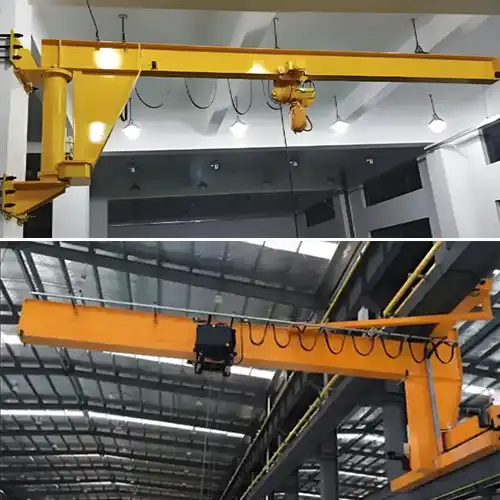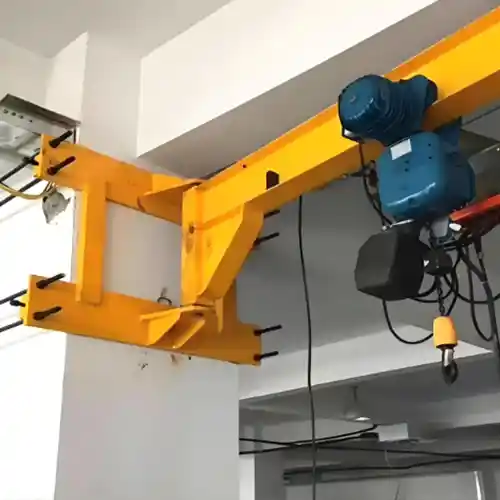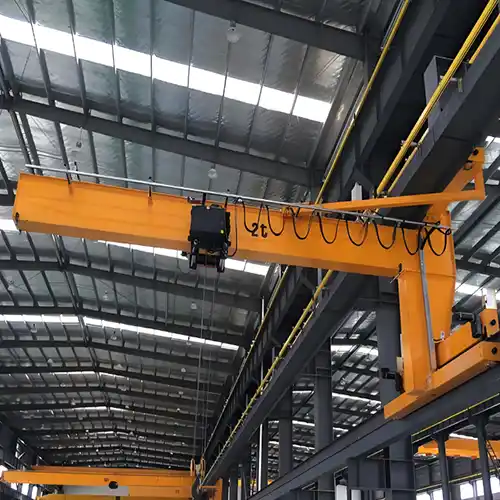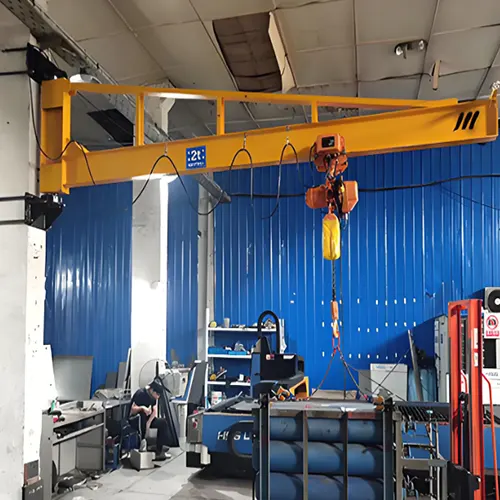Wall Cantilever JIb Crane : Wall traveling & Wall Mounted Cantilever Crane
Wall cantilever jib cranes include wall mounted for fixed reach and wall traveling for extended coverage along the wall. Get your custom wall jib crane.
Category: Wall Crane
Your Trusted Wall Jib Crane Manufacturer & Supplier
Wall Cantilever Jib Crane: Wall Traveling and Wall-Mounted Cantilever Crane
Wall cantilever jib cranes include wall mounted for fixed reach and wall traveling for extended coverage along the wall.The Wall Cantilever Jib Crane is a versatile lifting solution designed for both wall traveling and wall-mounted applications. It allows for efficient use of space and provides flexible coverage in areas with limited floor space. The wall traveling version moves along a fixed rail, offering extended reach and mobility, while the wall-mounted cantilever crane is fixed, ideal for localized lifting tasks. Both types are perfect for manufacturing, assembly, and maintenance applications, enhancing productivity and safety in your facility.
Wall Cantilever Jib Cranes
Wall cantilever jib cranes are a type of overhead crane designed to be mounted directly onto a wall or building structure. These cranes feature a horizontal arm, or jib, that extends outward from the wall, allowing it to lift and move materials within a specified radius. The arm is supported by a vertical post or cantilever that is anchored to the wall, providing stability and support for the crane's operations.
The primary purpose of wall cantilever jib cranes is to enhance material handling capabilities in areas with limited floor space. They are particularly useful in environments where a full overhead crane system might be impractical or where maximizing floor space is a priority. By utilizing the wall as a support structure, these cranes effectively free up valuable floor area for other uses.
Benefits of Using Wall Cantilever Jib Cranes in Various Applications
- Space Efficiency: Wall cantilever jib cranes are ideal for tight spaces where floor-mounted cranes would be cumbersome. Their design allows for the efficient use of vertical space, making them suitable for small workshops, warehouses, and manufacturing areas.
- Increased Flexibility: These cranes offer flexibility in material handling, allowing operators to reach various locations along the wall's length without requiring extensive floor space. This makes them valuable for tasks that require frequent repositioning of loads.
- Improved Workflow: By positioning the crane along the wall, it can streamline operations and reduce the time spent moving materials. This enhances overall productivity and efficiency in the workspace.
- Cost-Effectiveness: Wall-mounted cantilever jib cranes generally have lower installation and maintenance costs compared to full overhead crane systems. Their simplified design and use of existing building structures contribute to cost savings.
- Enhanced Safety: With less clutter on the shop floor and a stable mounting point, wall cantilever jib cranes help reduce the risk of accidents and injuries associated with material handling. Their fixed position ensures stability and precision during operation.
Overall, wall cantilever jib cranes are versatile tools that provide practical solutions for material handling in space-constrained environments, offering both efficiency and cost-effectiveness.
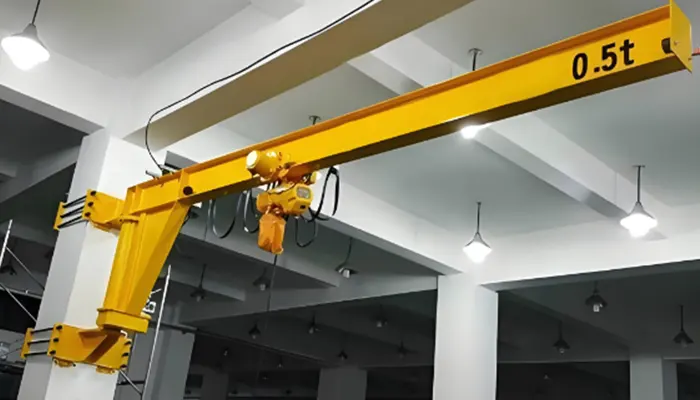
Wall Mounted Cantilever Jib Cranes for Sale
Wall-mounted cantilever jib cranes are ideal for maximizing floor space while providing efficient lifting solutions. Designed to be mounted on existing walls or columns, these cranes offer a 180-degree working range, perfect for repetitive tasks in manufacturing, assembly, and maintenance areas. With a robust design and adjustable boom length, they are suitable for a variety of applications and load capacities. Available for sale in custom sizes, these cranes enhance operational efficiency and improve workplace safety by handling heavy loads with ease.
Design and Structure
Wall mounted cantilever jib cranes are designed to maximize efficiency in limited space by anchoring directly to a building's wall. The core components of these cranes include:
- Jib Arm: The horizontal arm extends from the wall, providing the reach necessary to move materials within its operational range. It is typically made from robust steel or aluminum to handle varying loads.
- Vertical Support Post: This component is attached to the wall and provides vertical support for the jib arm. It ensures stability and allows the arm to handle substantial loads.
- Wall Bracket: The bracket secures the vertical support post to the wall. It is engineered to distribute the load evenly across the wall structure to prevent any damage.
- Hoist and Trolley: Mounted on the jib arm, the hoist raises and lowers loads, while the trolley allows horizontal movement along the jib's length.
Attachment to Building Walls
The installation process involves securing the wall bracket to a suitable wall, often a reinforced concrete or steel structure, using heavy-duty bolts and anchors. The vertical support post is then mounted to the bracket, ensuring it is aligned and securely fastened. This method of attachment leverages the wall's strength to support the crane's operations, minimizing the need for additional floor space.
Features and Benefits
Space-Saving Advantages
One of the main benefits of wall mounted cantilever jib cranes is their ability to save floor space. By attaching directly to the wall, these cranes keep the floor area clear, allowing for more effective use of the workspace. This is particularly beneficial in environments with limited room or where floor clutter needs to be minimized.
Ideal Applications and Environments
Wall mounted cantilever jib cranes are well-suited for:
- Small Workshops and Factories: In these settings, space is often at a premium. The crane's design allows for efficient material handling without occupying valuable floor space.
- Warehouses: They are used for moving goods along walls and shelves, facilitating quick access and reducing time spent retrieving items.
- Maintenance Areas: Ideal for areas where machinery needs frequent servicing, allowing tools and parts to be moved easily without obstructing the workspace.
Load Capacity and Range
Typical Load Capacities
Wall mounted cantilever jib cranes are available in various load capacities, typically ranging from 0.5 tons to 5 tons. The capacity depends on the crane's design, including the strength of the wall it is mounted on and the materials used in the crane's construction.
Range of Motion and Working Radius
The range of motion for wall mounted cantilever jib cranes varies based on the length of the jib arm. Generally, the working radius can extend from a few feet up to 15 feet or more, allowing for effective material handling within the designated area. The crane's ability to pivot around its mounting point enhances its versatility, enabling it to cover a broad operational zone while remaining anchored to the wall.
By integrating these features and understanding the design, applications, and capabilities, businesses can effectively leverage wall mounted cantilever jib cranes to optimize their material handling processes.

Wall Traveling Cantilever Jib Cranes
Design and Structure
Wall traveling cantilever jib cranes are engineered to offer enhanced mobility and flexibility by incorporating a wall-mounted system that allows the crane to travel horizontally along the wall.
Key components of these cranes include:
- Jib Arm: The horizontal arm extends from the wall and supports the hoist and trolley system. It is designed to handle various loads while providing a wide reach.
- Vertical Support Post: This component attaches to the wall and provides structural support for the jib arm. It ensures the crane remains stable during operation.
- Traveling Mechanism: Mounted on a rail or track system attached to the wall, this mechanism enables the crane to move horizontally along the wall's length.
- Hoist and Trolley: The hoist, mounted on the jib arm, handles vertical lifting, while the trolley allows for movement along the jib, providing horizontal flexibility.
Mechanism for Wall Travel and Movement
The wall traveling cantilever jib crane uses a rail or track system fixed to the wall, along which the crane moves. The rail system is typically installed at a height that allows for unobstructed movement along the wall. The crane is equipped with wheels or rollers that travel along these rails, enabling smooth horizontal movement. This system allows the crane to cover a larger area without requiring extensive floor space, making it suitable for environments where space is limited or requires dynamic usage.
Features and Benefits
Increased Flexibility and Coverage Area
One of the primary advantages of wall traveling cantilever jib cranes is their ability to cover a larger operational area compared to stationary wall-mounted cranes. By traveling along the wall, these cranes can access different points within the workspace, enhancing their versatility and efficiency. This feature is particularly useful for handling materials across long, narrow spaces or when working in confined areas where maneuverability is essential.
Ideal Applications and Environments
Wall traveling cantilever jib cranes are particularly effective in:
- Large Warehouses and Distribution Centers: They facilitate the movement of goods over extensive areas without occupying floor space, improving material handling efficiency.
- Manufacturing Plants: Ideal for production lines where components need to be moved along a lengthy assembly or processing area.
- Maintenance and Repair Shops: Useful for servicing equipment or machinery that requires access across a wide area.
Load Capacity and Range
Typical Load Capacities
The load capacities of wall traveling cantilever jib cranes generally range from 1 ton to 10 tons, depending on the crane's design and the strength of the wall it is mounted on. The crane's components, including the jib arm and traveling mechanism, are engineered to handle varying loads while maintaining stability during operation.
Range of Motion and Working Radius
The working radius of a wall traveling cantilever jib crane is influenced by the length of the jib arm and the extent of the rail system. Typically, the jib arm can extend from a few feet up to 30 feet or more, while the rail system allows the crane to travel the entire length of the wall on which it is mounted. This combination provides a significant range of motion, allowing the crane to handle materials across a broad area with flexibility and efficiency.
By understanding the design, features, and capabilities of wall traveling cantilever jib cranes, businesses can make informed decisions about integrating these systems into their operations to maximize material handling efficiency and workspace utilization.
Comparison of Wall Mounted vs. Wall Traveling Cantilever Jib Cranes
Wall mounted jib crane video
Wall travelling jib crane video
Design and Structure
Wall Mounted Cantilever Jib Cranes:
Design:
- These cranes feature a horizontal jib arm extending from a vertical support post anchored to the wall. The design focuses on stability and strength, relying on the wall for support.
- The structure is relatively straightforward, consisting mainly of the jib arm, support post, and mounting hardware.
Structure:
- The vertical support post is securely attached to the wall using heavy-duty bolts or brackets.
- The jib arm extends outward, and its length determines the fixed working radius.
Understanding the fundamental design and structure of each crane type is essential, but how they fit into your workspace is equally important. Let's explore how installation and space requirements differ for these two types of cantilever jib cranes.
Installation and Space Requirements
Wall Mounted Cantilever Jib Cranes:
Installation:
- Installation is straightforward, involving the mounting of the vertical support post and jib arm to the wall.
- Requires minimal preparation beyond ensuring that the wall can support the crane's load and properly aligning the components.
Space Requirements:
- These cranes use minimal floor space as they are mounted on the wall.
- Only the area directly in front of the wall is needed for operation, making them suitable for confined or limited floor spaces.
With installation and space considerations established, it's important to assess how each crane type performs in terms of operational efficiency. This will help determine which crane is better suited for different operational needs and productivity goals.
Operational Efficiency
Wall Mounted Cantilever Jib Cranes:
Efficiency:
- Operates efficiently within a fixed radius determined by the length of the jib arm.
- Ideal for handling tasks in specific, localized areas where extensive movement is not required.
Applications:
- Perfect for small workshops or confined spaces where the fixed range of movement is adequate.
- Suitable for tasks such as lifting and placing materials at a fixed location along the wall.
Wall Traveling Cantilever Jib Cranes:
Efficiency:
- Highly efficient for operations requiring extensive horizontal reach and flexibility.
- The ability to travel along the wall enhances operational efficiency by reducing the need to reposition the crane.
Applications:
- Best for large warehouses, manufacturing plants, or assembly lines where materials need to be moved over long distances or across wide areas.
- Effective in environments with dynamic material handling needs and extensive coverage requirements.
Now that we have covered operational efficiency, let's examine the load capacity and range of motion for each crane type. This will provide insight into their suitability for handling various loads and operational demands.
Load Capacity and Range
Wall Mounted Cantilever Jib Cranes:
Load Capacity:
- Typically handles loads ranging from 1 to 5 tons, depending on the wall strength and crane design.
- Load capacity is limited by the wall's ability to support the crane and the jib arm's design.
Range of Motion:
- The working radius is fixed, determined by the length of the jib arm.
- Limited to the area directly in front of the wall, which can restrict the operational range.
Wall Traveling Cantilever Jib Cranes:
Load Capacity:
- Can handle a broader range of loads, generally from 1 to 10 tons or more, depending on the rail system and crane design.
- The rail system supports greater load capacities due to its design and installation.
Range of Motion:
- Offers extended working coverage due to the ability to travel along the wall.
- Covers the entire length of the rail system, providing greater flexibility and access across a larger area.
With a clear understanding of load capacities and range, the final consideration involves cost. Comparing the initial and long-term costs of each crane type will help in making a financially informed decision.
Cost Considerations
Wall Mounted Cantilever Jib Cranes:
Initial Costs:
- Generally lower due to the simpler design and installation requirements.
- Fewer components and less complex installation result in lower upfront costs.
Long-Term Costs:
- Lower maintenance and operational costs due to the absence of moving parts and a simpler system.
- Ideal for fixed or less demanding applications where long-term costs are a major consideration.
Wall Traveling Cantilever Jib Cranes:
Initial Costs:
- Higher due to the added cost of the rail system and more complex installation.
- The investment includes both the crane and the rail or track system.
Long-Term Costs:
- Potentially higher maintenance costs due to the rail system and moving parts.
- Increased efficiency and broader coverage can offset these costs in environments with extensive material handling needs.
Summary
- Wall Mounted Cantilever Jib Cranes are best for smaller, localized applications requiring a fixed working radius and minimal floor space usage. They offer a simpler, cost-effective solution but are limited in working coverage and load capacity.
- Wall Traveling Cantilever Jib Cranes provide extended working coverage and greater flexibility, making them ideal for larger or more complex environments. Despite higher initial and potential long-term costs, their efficiency and extended range can make them a more practical choice for extensive or dynamic operations.
Applications and Use Cases
Industrial and Manufacturing Settings
Common Uses in Factories and Production Lines
Wall mounted and wall traveling cantilever jib cranes are integral to many industrial and manufacturing environments, offering solutions tailored to various production needs.
Wall Mounted Cantilever Jib Cranes:
- Assembly Lines: Ideal for tasks that require lifting and positioning components at fixed points along the assembly line. Their fixed radius and stable structure support precise and repetitive operations.
- Maintenance: Useful for handling tools and parts in maintenance areas, providing access to hard-to-reach locations without obstructing the floor space.
Wall Traveling Cantilever Jib Cranes:
- Production Lines: Perfect for long production lines where materials need to be moved over significant distances along the wall. Their ability to travel enhances flexibility and efficiency in material handling.
- Heavy Machinery: Effective for lifting and positioning heavy machinery components within factories, offering extensive reach and flexibility.
Warehouse and Logistics
Efficiency Improvements in Handling and Moving Materials
In warehouses and logistics centers, cantilever jib cranes play a crucial role in streamlining material handling and improving operational efficiency.
Wall Mounted Cantilever Jib Cranes:
- Small to Medium Warehouses: Provides efficient material handling in smaller or medium-sized warehouses where floor space is limited. Their fixed reach is ideal for localized tasks and optimizing space utilization.
- Order Picking: Facilitates the picking and placement of items in specific storage locations, reducing the need for additional equipment.
Wall Traveling Cantilever Jib Cranes:
- Large Warehouses: Offers significant advantages in large warehouses with extensive storage areas. The ability to move along the wall allows for the efficient handling of goods over longer distances.
- Loading and Unloading: Enhances the loading and unloading process by covering a broad area, improving efficiency in high-volume logistics operations.
Specialized Applications
Use in Specific Industries such as Automotive, Aerospace, and Construction
Cantilever jib cranes are versatile and adapt well to specialized applications across various industries.
Automotive:
- Assembly and Manufacturing: Wall traveling cantilever jib cranes are ideal for automotive assembly lines, where they can handle parts and tools across long production lines. They improve workflow efficiency and reduce manual handling.
- Parts Handling: Wall mounted cranes are used for handling specific parts in smaller, localized areas, such as engine assembly stations or maintenance bays.
Aerospace:
- Component Handling: In aerospace manufacturing, wall mounted and wall traveling cranes support the handling of large and delicate components. They ensure precision in moving parts such as aircraft wings and fuselage sections.
- Maintenance and Repair: Wall mounted cranes are used in maintenance areas for lifting and positioning aircraft parts, providing accessibility without interfering with other operations.
Construction:
- Site Logistics: On construction sites, wall traveling cantilever jib cranes assist in moving materials and tools across large areas. They are useful for handling heavy construction materials and equipment.
- Assembly: Wall mounted cranes support assembly tasks in prefabrication areas, where their fixed reach is suited for handling components in a controlled environment.
Summary
- Wall Mounted Cantilever Jib Cranes are best for localized tasks and smaller spaces, offering precision and stability in industrial, warehouse, and specialized settings.
- Wall Traveling Cantilever Jib Cranes excel in environments requiring extensive coverage and flexibility, making them ideal for large warehouses, production lines, and specialized industry applications where broad reach and efficiency are crucial.
Maintenance and Safety
Maintenance Practices
Regular Inspection and Servicing Requirements
Wall Mounted Cantilever Jib Cranes:
Routine Inspections:
- Daily Checks: Inspect the jib arm and support post for visible signs of wear or damage. Ensure that all bolts and brackets are secure and that there are no signs of instability or misalignment.
- Weekly and Monthly Inspections: Conduct more thorough inspections, including checking for signs of corrosion or deterioration, verifying the integrity of the wall mounting, and ensuring the proper functioning of all moving parts and safety devices.
Servicing Requirements:
- Lubrication: Regularly lubricate moving parts, such as bearings and joints, to prevent wear and maintain smooth operation.
- Load Testing: Periodically test the crane's load capacity to ensure it can handle the maximum rated loads safely. This testing should be conducted by a qualified technician.
- Wall Integrity: Check the condition of the wall to which the crane is mounted. Look for any signs of damage or weakening that could affect the crane's stability.
Wall Traveling Cantilever Jib Cranes:
Routine Inspections:
- Daily Checks: Examine the rail or track system for obstructions or damage, and ensure that the crane travels smoothly along the wall. Inspect the jib arm, support post, and rail connections for signs of wear.
- Weekly and Monthly Inspections: Conduct detailed inspections of the rail system and all moving parts. Look for wear and tear, check alignment, and verify that all components are functioning correctly.
Servicing Requirements:
- Lubrication: Regularly lubricate the rail system and moving parts to ensure smooth operation and prevent excessive wear.
- Track Maintenance: Clean and maintain the rail or track system to avoid obstructions and ensure smooth movement. Address any issues with alignment or wear promptly.
- Load Testing: Perform load tests to ensure the crane operates safely within its rated capacity. This testing should be carried out by a certified technician.
Transition: Proper maintenance is crucial to ensuring the safe and efficient operation of cantilever jib cranes. Equally important are the safety measures and protocols designed to protect operators and maintain a safe working environment. Let's explore the key safety considerations for both types of cranes.
Safety Considerations
Safety Measures and Protocols
Wall Mounted Cantilever Jib Cranes:
Load Handling:
- Ensure that loads do not exceed the crane's rated capacity. Overloading can lead to structural failure or instability.
- Use appropriate lifting techniques and equipment to prevent accidental dropping or swinging of loads.
Operator Training:
- Operators should be thoroughly trained in the safe use of wall mounted cantilever jib cranes. Training should include load handling procedures, emergency protocols, and regular safety updates.
Inspection and Maintenance:
- Regular inspections and maintenance should be conducted to identify and address any potential safety issues. This includes checking for signs of wear, ensuring proper installation, and verifying that safety devices are operational.
Emergency Procedures:
- Develop and communicate emergency procedures for dealing with crane malfunctions or accidents. Ensure that operators are familiar with these procedures and know how to respond effectively.
Wall Traveling Cantilever Jib Cranes:
Load Handling:
- Similar to wall mounted cranes, ensure that loads do not exceed the crane's rated capacity and use safe lifting practices.
- Regularly check the rail or track system for obstructions or defects that could affect safe operation.
Operator Training:
- Operators must be trained in the specific safety protocols for wall traveling cranes, including the operation of the rail system and the safe handling of loads over long distances.
Inspection and Maintenance:
- Regular maintenance of the rail or track system is crucial for safe operation. This includes checking for wear, alignment issues, and ensuring that the system is free from obstructions.
- Safety checks should include verifying the functionality of all safety features, such as limit switches and emergency stop mechanisms.
Emergency Procedures:
- Implement and communicate clear emergency procedures for handling crane malfunctions, including issues with the rail system and load handling problems. Ensure that operators are trained to handle emergencies effectively.
Summary
- Wall Mounted Cantilever Jib Cranes: Maintenance involves regular inspections, lubrication, and load testing, with a focus on the stability of the wall and the crane's fixed radius. Safety measures include load handling protocols, operator training, and emergency procedures. Wall Traveling Cantilever Jib Cranes: Maintenance includes more extensive checks of the rail system and moving parts, along with regular load testing. Safety considerations involve ensuring smooth rail operation, comprehensive operator training, and effective emergency response procedures.
By adhering to these maintenance practices and safety protocols, you can ensure the reliable and safe operation of both wall mounted and wall traveling cantilever jib cranes, minimizing downtime and enhancing overall workplace safety.
Conclusion
In this comprehensive overview, we've explored the essential aspects of wall mounted and wall traveling cantilever jib cranes, including their design, features, and applications.

Wall Mounted Cantilever Jib Cranes:
- Design: Feature a fixed jib arm extending from a vertical support post attached to a wall. The structure is straightforward, emphasizing stability and strength.
- Features and Benefits: Provide a fixed working radius suitable for smaller, more defined work areas. Ideal for tasks in confined spaces, assembly lines, and maintenance areas. Space-saving and cost-effective for specific applications.
- Applications: Commonly used in small workshops, assembly lines, and maintenance operations where extensive movement is not required.

Wall Traveling Cantilever Jib Cranes:
- Design: Equipped with a rail or track system that allows horizontal movement along the wall, providing an extended working range.
- Features and Benefits: Offer increased flexibility and coverage by moving along the wall, making them suitable for larger or more dynamic environments. Efficient in handling materials over long distances and across broad areas.
- Applications: Ideal for large warehouses, production lines, and specialized industries such as automotive and aerospace, where extensive material handling is needed.
Choosing the Right Crane
Selecting between wall mounted and wall traveling cantilever jib cranes depends on specific operational needs and workspace conditions. Here are some guidelines to help in the decision-making process:
Assess Your Workspace:
- Wall Mounted Jib Cranes: Best for environments with limited space or where the crane will primarily serve localized tasks. Suitable for smaller areas with a fixed operational radius.
- Wall Traveling Jib Cranes: Ideal for larger facilities or those requiring extensive coverage along the wall. Choose these cranes if your operations involve moving materials over significant distances or if you need greater flexibility.
Evaluate Load Requirements:Consider the maximum load capacities and the type of materials handled. Wall traveling cranes offer higher flexibility and coverage for handling heavier or more varied loads over larger areas.
Consider Space and Installation:
- Wall Mounted Cantilever Jib Cranes: Generally easier and less costly to install, with fixed space requirements.
- Wall Traveling Cantilever Jib Cranes: Require additional space for the rail system and may involve more complex installation processes.
Operational Efficiency:
- Wall Mounted Cantilever Cranes: Offer efficient operation in smaller or fixed areas with less need for movement.
- Wall Traveling Cantilever Cranes: Provide greater efficiency in handling tasks that span larger distances or where dynamic movement along the wall is advantageous.
By understanding the features, benefits, and specific applications of each type of crane, you can make an informed decision that best fits your operational needs and enhances your overall material handling efficiency.
Related Products

Latest project
150 Ton Overhead Crane Installation Feedback – Paraguay Case
QDX 150 ton overhead crane in action in Paraguay. Installation photos, video, and client feedback show performance, safety, and heavy-lifting efficiency.
Free consultation to Confirm Parameters & Specifications and Get
Latest Crane Price & Crane Rate.
- Types of overhead cranes : _______?
- Optional: Overhead travelling crane, goliath gantry crane,Slewing jib crane, Single girder or double girder crane,small portable crane or kbk crane, etc.
- Capacity of overhead crane: _______?
- Optional: 0.25ton, 0.5 ton, 1 ton, 2 ton, 3ton, 5 ton, 10 ton,15ton, 20ton, 25 ton, 30ton,35ton, up to 550ton, etc.
- Crane span & lifting height : _______?
- Crane travelling length : _____?
- Control of overhead crane:_______?
- Optional: pendant/ remote/cabin control
- Voltage supply of overhead crane:_____?
- Eg,: 380V50/60HZ,3Phase or others,etc.
- Application/usage of crane:_______?
- Eg,: Steel mill, ,injection mold, cement,stone, concrete,granite, general manufacturing, etc.
Just leave a message via the contact form and our hoist and crane engineer will contact you with in 24working hours.
Get In Touch
